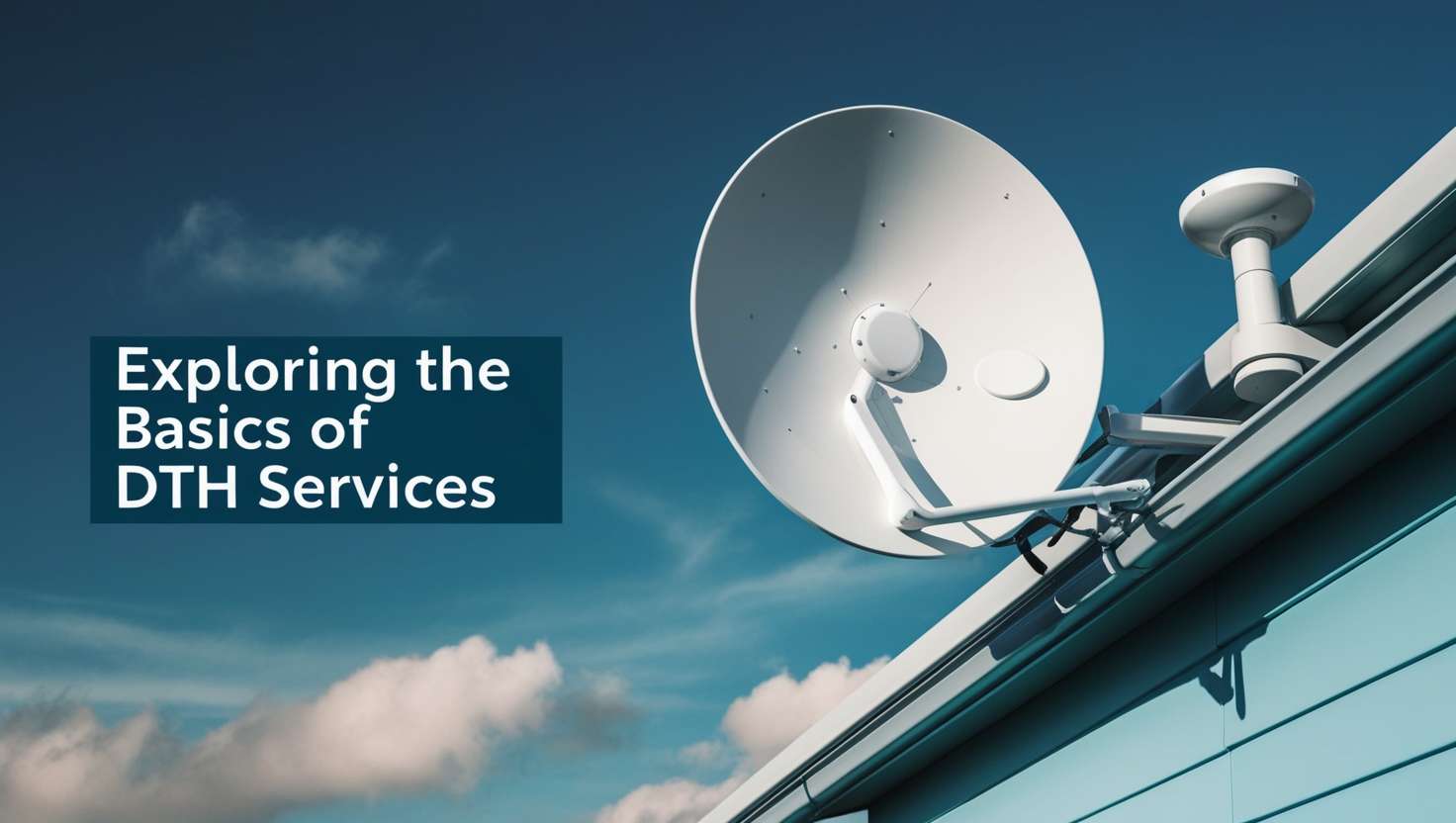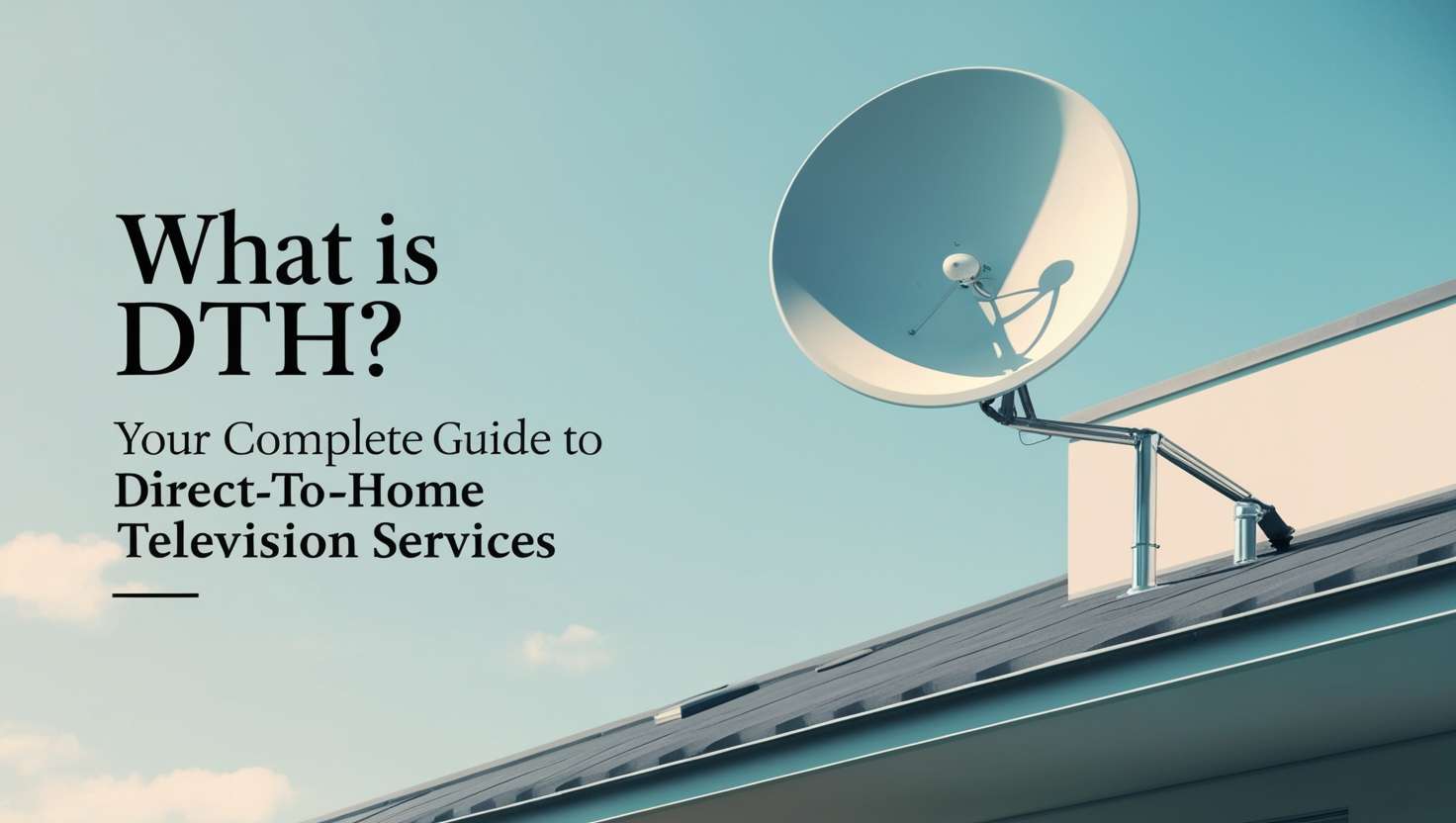Table of Contents
ToggleIntroduction
In a world filled with many entertainment options, satellite television stands out. It offers a full television service right at your home. DTH, which means Direct-to-Home, uses satellite technology. This helps provide better signal quality and a wide range of channels for different viewers. But what is DTH, and how is it different from regular cable ? Let’s take a closer look at DTH services.
Key Highlights
- DTH stands for Direct-to-Home, a satellite television service that delivers television content straight to your home.
- It eliminates the need for intermediaries like cable operators, offering greater flexibility and a wider range of channels.
- Enjoy superior picture and sound quality with high-definition (HD) channels.
- Customize your channel selections and packages based on your viewing preferences.
- DTH (Direct-to-Home) is a viable option for viewers in rural or underserved areas with limited cable connectivity.

Exploring the Basics of DTH Services
Imagine a system where television signals come directly from space. This means you don’t need tricky wires or limited connections. This is DTH, a new technology that has changed how millions watch TV. DTH links satellites straight to your television. This gives viewers great convenience, more choices, and better quality.
DTH providers use a network of satellites in orbit to share many channels and services. Subscribers get these signals with a small dish antenna at their home. This setup removes the limits of old cable systems. The direct link makes watching TV more stable and enjoyable. Now, viewers are not held back by where they live or by cable lines.
Full Form of DTH
DTH means Direct-to-Home. It has changed how we receive television signals. Unlike regular cable TV, which uses cables, DTH uses satellites to send signals straight to your home. This makes it easy to get a DTH connection anywhere there is a clear view of the sky. It’s great for people in rural areas or places where cable service is not good.
With DTH technology, viewers do not need local cable operators. Signals go directly from the broadcaster to the set-top box via satellite. This means you get clearer images, better colors, and improved sound.
You also have a wider range of channels and services with DTH. This includes high-definition (HD) channels, regional channels, and many interactive services.
SEE ALSO : Full Form of AM and PM, Meanings, and their Relationship with the 24-Hour clock
The Evolution and Adoption of DTH Globally
The introduction and growth of DTH technology changed the television broadcasting world. It created a new time for better watching experiences. As technology got better, DTH also improved. Now, high definition channels are common, giving us clear picture quality.
DTH signals come from strong satellites. They can reach even the farthest areas of the planet. Because these signals are easy to get, many people across the world started using DTH quickly. DTH providers saw this rising need and increased their services.
They now offer a wide range of channels, along with interactive choices and extra features.Today, DTH plays a significant role in the global television market. It keeps changing to meet what viewers want more and more.
How DTH Technology Revolutionizes Television Viewing
DTH technology has changed how we watch TV. It gives people many choices and control that they didn’t have before. There are many channels available that match different interests and languages. Viewers can enjoy a variety of options, unlike the limited ones from cable TV.
Additionally, DTH’s direct-to-home system delivers a steady signal quality. This means viewers don’t have to worry about problems that can happen with cable networks. The result is a smooth and enjoyable viewing experience without interruptions or signal issues.
The Technical Mechanics Behind DTH Broadcasting
The magic of dish TV comes from how it uses advanced technology to send and receive digital TV signals. It starts at a broadcasting center. Here, TV programs are transformed into digital signals and transmitted to a satellite orbiting the Earth.
This satellite acts like a relay station. It gets the digital TV signals and sends them back down to a specific area on Earth. A small dish antenna at the subscriber’s home catches these signals, working like a tiny satellite receiver.
Next, the signals go to a set-top box. This box decodes the signals and turns them back into a format your television can use. The result is a great selection of channels and services brought right to your living room with clear pictures and sound quality.
Comparing DTH with Traditional Cable Services
DTH and cable TV have different ways of providing television broadcasts. Each option comes with its own set of advantages and disadvantages.
Cable TV uses a large network of coaxial cables to send TV signals to homes. This system is well-known and trusted. In contrast, DTH uses satellites. This means DTH does not need physical cables to work.
One main benefit of DTH is that it gives a better picture and sound quality than cable. Satellite signals often have less interference, which means they keep a steady viewing quality. DTH also has more channels and services since it isn’t limited by cable lines. Additionally, DTH provides:
- Wider Coverage: DTH can reach remote places because it does not depend on the geography that cables do.
- Interactive Features: DTH usually has options like electronic program guides, video-on-demand, and interactive games. These features make watching more enjoyable.
However, cable TV can still be better in some ways, especially in cities where the cable network is strong. Cable connections often stay stable even in bad weather, as heavy rain or snow can disrupt satellite signals.
Advantages and Disadvantages of Opting for DTH Over Cable
| No | Aspect | Advantages of DTH | Disadvantages of DTH |
|---|---|---|---|
| 1. | Picture & Sound Quality | Enhanced clarity and immersive sound with digital signals | Signal interruptions during adverse weather conditions |
| 2. | Channel Variety | Access to a wide range of channels including HD and UHD content | Higher initial setup costs |
| 3. | Coverage & Accessibility | Wide coverage, ideal for remote areas | Limited availability in urban centers |
| 4. | Customization | Customizable channel packages to suit viewer preferences | Dependency on clear sky for satellite reception |
| 5. | Premium Content | Offers premium content such as movies, sports, and documentaries | Potential for service disruptions during severe weather |
| 6. | Flexibility | Flexible subscription plans with options to choose desired channels | Dependency on satellite positioning and alignment |
The Challenges and Limitations of DTH
DTH has many benefits, but it also comes with some challenges. One major problem is that the signal can be interrupted during bad weather. Heavy rain, snow, or storms may block the transmission from satellites to the dish antenna. This can cause a temporary loss of signal.
Also, the cost to set up DTH can be high. You need to buy a dish antenna, a set-top box, and pay for installation. Some people may see this as a barrier. Still, the long-term benefits of DTH, like custom channel packages and high-quality picture, usually make up for the initial costs.
Potential Drawbacks and User Concerns
Despite the many benefits of DTH, there are some downsides to think about when looking at this technology. One main worry is that DTH signals can be affected by bad weather. Heavy rain, snow, or thick clouds can disrupt signals between satellites and the dish antenna. This can lead to temporary loss of service.
Although DTH usually has more channel packages than regular cable connections, the cost can be a problem for some users. The cost of DTH equipment, like the dish, set-top box, and installation, may be more compared to cable.
Also, DTH technology may not work well in every place. In busy cities, tall buildings can block the view between the dish antenna and the satellite. This can make receiving signals harder.
Addressing Signal Interruption Issues
Signal interruptions are a key worry for DTH users. DTH uses a satellite system to send TV signals. This means that bad weather, like heavy rain, snow, or thick clouds, can block the signals and cause temporary issues.
While we can’t fully remove weather-related problems, DTH providers work hard to lessen their effects. New DTH systems use advanced technologies to improve signal reception and reduce disruptions. For example, high-gain antennas help catch weaker signals, which can make performance better during bad weather.
Also, picking a DTH provider with strong infrastructure and well-placed satellites can help improve signal reliability. Before you sign up, ask about the coverage of the network and any service guarantees they have for weather issues. This way, you can enjoy a clear HD connection most of the time.
Major DTH Providers in the United States
The United States has a strong DTH market. Many top providers compete for the top spot. Two of the biggest names are DISH Network and DIRECTV. They both provide coverage across the country and offer a wide range of channels and services.
These DTH leaders serve different types of viewers. They have flexible package options, premium content, and new technologies to improve your viewing experience. Consumers can pick from different plans. There are options for sports fans, movie lovers, and families with different entertainment needs.
A Closer Look at Leading DTH Service Providers
DTH services have grown a lot. This growth comes from the high demand for more choices and flexibility with TV channels. Many providers have joined the market, hoping to get their share. Tata Sky is an important name, especially in India.
Tata Sky is known for its wide coverage and many channel options. It has become a symbol of good DTH services. Tata Sky has many packages for different budgets and interests. They offer everything from regional language channels to international sports and entertainment, making sure viewers have an excellent experience.
Other important players in the DTH market worldwide include DISH Network and DIRECTV in the United States. They are recognized for their advanced technology and a wide variety of programs. The competition in this market helps customers enjoy improving services, fair pricing, and new features.
Comparing Different DTH Plans and Offerings
Navigating the diverse offerings of DTH providers can initially seem overwhelming, given the multitude of plans, packages, and add-on options. Tata Play, formerly known as Tata Sky, stands out for its comprehensive channel lineup and innovative services, while Pantel Technologies has gained traction with its budget-friendly packages and focus on regional content.
When comparing DTH plans, consider factors like the selection of channels, package pricing, and availability of HD or UHD options. Additional features, such as multi-room connections, DVR services, and interactive apps, can significantly enhance the viewing experience.
| Feature | Tata Play | Pantel Technologies |
|---|---|---|
| Channels | Extensive selection of international and regional channels | Focuses on regional channels, limited international options |
| Pricing | Competitive with various subscription tiers | Budget-friendly, often lower prices |
| HD/UHD | Offers HD and UHD channels | HD available in select packages |
| DVR | DVR (Digital Video Recorder) available | Limited availability of DVR |
| Interactive Features | VOD, multi-room connections, parental controls | Basic VOD options, fewer interactive features |
| Technology | Advanced technology, strong signal reliability | Traditional satellite technology, occasional disruptions |
| Additional Services | Content recommendations, enhanced viewing features | Basic services with fewer add-ons |
| Coverage | Wide coverage including remote areas | Mainly urban and suburban availability |
The Role of DTH in the Era of Streaming and OTT Platforms
Streaming services and Over-The-Top (OTT) platforms have changed the face of traditional television. This change brings both challenges and chances for DTH providers. Cable operators have seen many subscribers leave. In contrast, DTH providers like Airtel Digital TV have adapted and shown strength.
DTH has a clear benefit in areas with poor internet access or bad broadband connections. It can provide good-quality TV signals, even in remote places. This keeps DTH important in growing markets. DTH providers are also teaming up with OTT platforms. They now offer streaming services together with their regular packages.
This move lets DTH operators meet the new demands of viewers who want both live TV and on-demand content. By embracing this connection, DTH providers can strengthen their role in the changing world of entertainment and give viewers a complete TV experience.
SEE ALSO : The Heeramandi Cast: A Sneak Peek into Bollywood’s Epic Period Drama
Conclusion
In conclusion, understanding DTH technology helps us see what the future of watching TV will be like. It offers better picture quality, customizable channels, and new trends that change how we enjoy entertainment. Choosing DTH can solve some issues with signal drops and user problems compared to regular cable. As streaming services keep growing, DTH is still a strong choice for anyone wanting high-quality and personalized viewing. Embrace the improvements in DTH services to enhance your entertainment choices and keep up with changes in television broadcasting.
Frequently Asked Questions About DTH
DTH stands for Direct-to-Home. It sends television programming directly to an antenna at a subscriber’s home. This is different from cable, which uses physical wires. It also differs from streaming, which needs an internet connection for audio and video content.
Choosing a DTH provider means you need to think about what you want and need. Look at the channels offered by the broadcaster. Check the prices for the packages too. Make sure they serve your area. Also, see if there are any extra features that matter to you. Websites that compare providers can show helpful details and user reviews.
DTH offers more options for customizing your subscription than regular cable bundles. Most providers provide different packages. These can be based on language, genre, or premium channels. You can change your choices and see an overview of the costs.
Common DTH problems usually include losing the signal. Look for things that might block your dish. If you pay for channels, make sure your account is active. For FTA channels, weather can cause interference that affects usage.
DTH means Direct-to-Home television service. It sends satellite signals straight to your set-top box. This is different from cable or internet streaming. DTH uses its own satellite connection. It also has hybrid options for internet-based VOD content.
DTH payment stands for Direct-to-Home payment, a convenient mode for subscribers to pay for DTH services. It streamlines the billing process, allowing users to make payments seamlessly from the comfort of their homes.
DTH (Direct-to-Home) and DishTV are not the same. DTH is a technology that enables satellite broadcasting directly to users’ homes, while DishTV is a brand offering DTH services. They are distinct in terms of technology and service providers.
DTH, or Direct-To-Home, in media refers to satellite television broadcasting directly to subscribers’ homes. It allows for a wide range of channels, high-quality picture and sound, and interactive services. DTH revolutionizes TV viewing by offering a diverse array of content directly to viewers.




2 thoughts on “What is DTH? Your Complete Guide to Direct-to-Home Television Services”